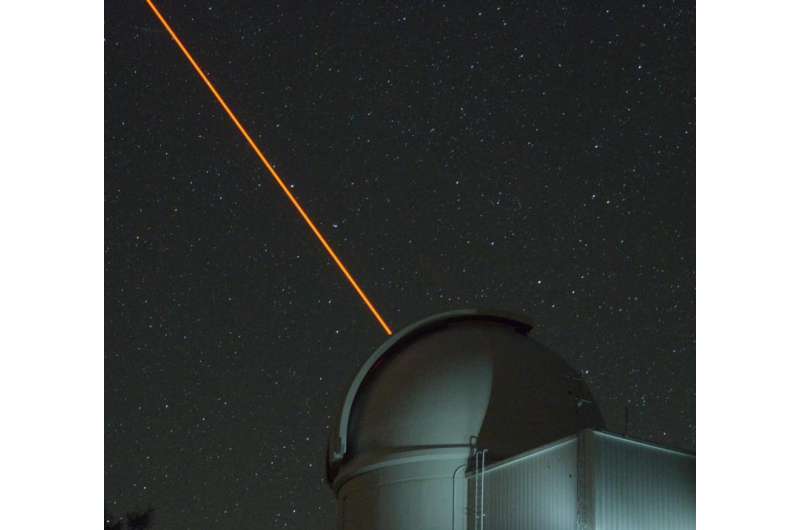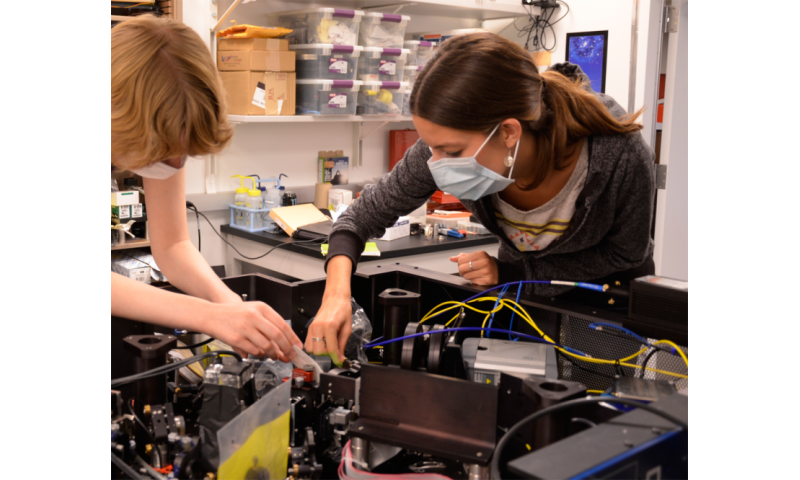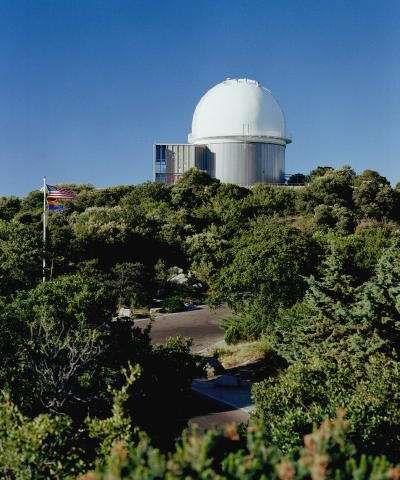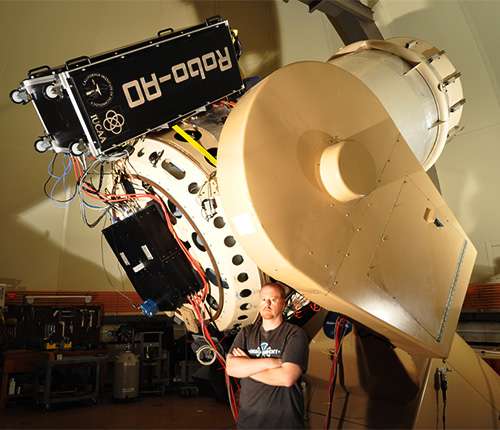Robotic laser astronomy on the rise

The world's first robotic laser adaptive optics system, developed by a team led by University of Hawaiʻi at Mānoa astronomer Christoph Baranec, will soon find a new home at the venerable 2.1-meter (83-inch) telescope at Kitt Peak National Observatory in Arizona. This system, renamed Robo-AO KP, will be the world's first dedicated adaptive optics astronomical observatory and will allow astronomers to take an unprecedented number of highly detailed images of a wide range of celestial objects.
The prototype Robo-AO system has been operational on a part-time basis at the Palomar Observatory 1.5-meter (60-inch) telescope since 2011, and has been an indispensable tool for many areas of astronomy: It has confirmed thousands of exoplanet discoveries made by NASA's Kepler mission and measured the rates at which different types of stars are born into single, double, triple and even quadruple star systems.
The Robo-AO team even recently discovered one of only two known quadruple star systems containing planets. Once the system becomes Robo-AO KP after its transfer to the Kitt Peak telescope later in 2015, the team will be able to take on much more ambitious projects.
Baranec led the development of Robo-AO when he worked at the California Institute of Technology (Caltech). Other core members of the Robo-AO team include Reed Riddle (Caltech), Nicholas Law (now at the University of North Carolina at Chapel Hill) and Shri Kulkarni (Caltech). The same team, under the leadership of Kulkarni and Caltech, will be responsible for the overall deployment and operation of the Robo-AO KP system. Baranec is responsible for adapting Robo-AO to the new telescope optics and adding an additional infrared science camera based on new technologies being developed by fellow UH astronomer Donald Hall.
"Not only will we now have the necessary observing time for adaptive optics surveys that were previously thought to be impractical, but we'll also be augmenting our back-end cameras with new technology developed in Hawaii," said Baranec. "I'm also excited that students from Hawaii are deeply involved in preparing Robo-AO for its move, deploying the new camera, and planning for several of the upcoming science surveys," he added.
In addition, Baranec is developing an upgraded Robo-AO system for the UH 2.2-meter (88-inch) telescope on Maunakea that will be even more powerful and will be equipped with additional instruments for studying nearby supernovae and cosmology in the local universe.
Robo-AO uses an ultraviolet laser to create an artificial guide star in the sky to measure the blurring caused by Earth's atmosphere. By measuring how the atmosphere affects this artificial star, a deformable mirror in the system can be commanded to remove its blurring effects. Because light from the laser and celestial objects pass through the same atmosphere, and both are reflected off of the deformable mirror, images of celestial objects are similarly de-blurred, leading to very sharp images limited only by the same laws of physics that limit the sharpness of space-based telescopes.
As its name implies, Robo-AO KP will operate autonomously, making it the most efficient adaptive optics system in use today. (There will still be a telescope operator to handle routine opening and closing of the dome and monitoring of the weather.) Its invisible ultraviolet laser guide star beam will not distract or affect airplane pilots, or produce radiation that is hazardous during momentary exposures. Additionally, two months of observing time each year will be available to the broad United States astronomical community, which thus far has had only limited access to Robo-AO.
-

Figure 2: Graduate students Rebecca Jensen-Clem (Caltech) and Maissa Salama (UH) rebuilding Robo-AO so it can be used on the 2.1-meter telescope at Kitt Peak National Observatory. Credit: C. Baranec. -

Figure 3: The 2.1-meter telescope at Kitt Peak National Observatory. -

Figure 4: Christoph Baranec with Robo-AO on the 60-inch Palomar telescope. Credit: C. Baranec
Provided by University of Hawaii at Manoa





















